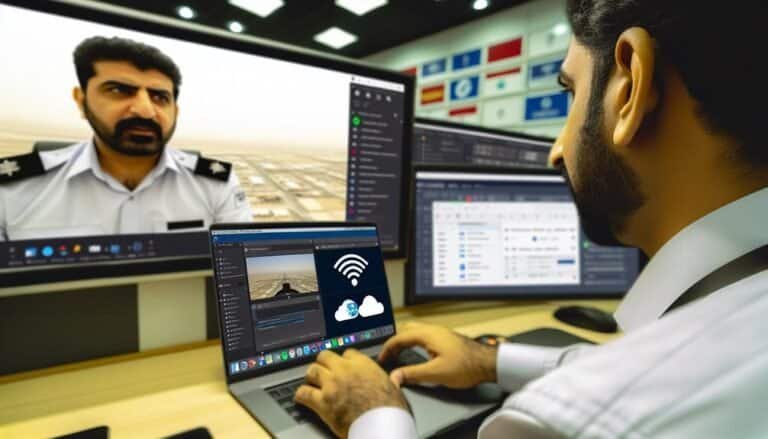Fostering Innovation and Creativity in Remote Work Settings
In today's rapidly evolving professional landscape, the shift towards remote work has necessitated a reevaluation of traditional approaches to fostering innovation and creativity within teams.
As organizations adapt to the challenges and opportunities presented by remote work settings, the need to cultivate an environment that nurtures inventive thinking and collaborative ideation has become increasingly paramount.
However, the question remains: how can businesses effectively harness the potential for innovation and creativity in a remote work context?
This discussion will explore strategies and best practices for empowering remote teams to thrive creatively and drive innovation, ultimately redefining the way we approach and achieve success in a virtual work environment.
Key Takeaways
- Importance of building virtual collaboration platforms to enhance creativity and innovation in remote work settings
- Cultivating a creative mindset through remote brainstorming sessions and virtual creativity workshops
- Empowering remote teams through clear communication channels, flexibility, recognition, and support
- Leveraging technology, such as advanced communication tools and immersive virtual reality environments, to foster innovation and generate valuable insights in remote work settings
Understanding Remote Work Dynamics
In the ever-evolving landscape of remote work, understanding the dynamics at play is crucial for fostering a productive and cohesive virtual work environment. Remote work presents unique challenges, such as communication barriers, feelings of isolation, and the need for self-discipline.
To counter these challenges, implementing effective communication strategies is paramount. Encouraging open and transparent communication through regular video conferences, instant messaging platforms, and project management tools can bridge the gaps created by physical distance. Moreover, establishing clear guidelines for response times and availability helps manage expectations and ensures timely communication.
Understanding the nuances of remote work dynamics involves recognizing the impact of time zone differences, cultural diversity, and varying work habits on team collaboration. By acknowledging these factors, leaders can tailor communication strategies to accommodate diverse perspectives and create an inclusive environment.
Furthermore, providing opportunities for virtual team-building activities and fostering a culture of empathy and understanding can enhance cohesion within remote teams.
In essence, comprehending remote work dynamics and implementing effective communication strategies are essential for overcoming challenges and nurturing a thriving virtual work environment.
Building Virtual Collaboration Platforms
Amid the complexities of remote work dynamics, the creation of virtual collaboration platforms becomes a pivotal endeavor in fostering innovation and creativity within dispersed teams. Building virtual collaboration platforms is essential for enabling remote teams to engage in seamless and productive interactions. Here are key strategies for establishing effective virtual collaboration platforms:
- Virtual Brainstorming Sessions: Implementing virtual brainstorming sessions allows team members to contribute ideas and insights regardless of their geographic location. Online ideation tools such as digital whiteboards and collaborative idea management platforms facilitate the generation and sharing of creative ideas in real-time.
- Remote Team Building: Cultivating a sense of unity and camaraderie among remote team members is crucial for fostering a collaborative environment. Employing digital collaboration techniques, such as virtual team-building activities and online social gatherings, can help strengthen relationships and enhance teamwork despite physical distance.
- Integrated Communication Tools: Utilizing integrated communication tools that offer features such as video conferencing, instant messaging, and file sharing is essential for promoting seamless collaboration. These tools facilitate real-time communication and the sharing of resources, enabling teams to work together efficiently and effectively.
Cultivating a Creative Mindset
Cultivating a creative mindset is essential for remote teams to thrive in their pursuit of innovation and adaptability in a virtual work environment. Creative problem solving becomes crucial as team members need to navigate challenges without the luxury of face-to-face interactions. Remote brainstorming sessions offer a platform for individuals to share ideas and collaborate on solutions, fostering an atmosphere of collective creativity.
Moreover, virtual creativity workshops can be instrumental in nurturing a creative mindset among remote teams. These workshops can provide team members with tools and techniques to tap into their creative potential, encouraging them to approach tasks with fresh perspectives.
Additionally, remote team building activities can play a significant role in cultivating a creative mindset. Building strong interpersonal relationships and fostering a sense of community within the team can lead to increased trust and open communication, essential components for fostering creativity and innovation.
Empowering Remote Teams
Navigating the virtual work landscape with a creative mindset, remote teams can further excel by empowering their members to take ownership of their roles and contribute to the collective success.
Empowering autonomy and fostering trust in remote teams are crucial for enhancing productivity and creativity. Here are three key strategies for empowering remote teams:
- Clear Communication: Establishing transparent communication channels and providing regular updates help in fostering trust among team members. It also empowers them to make informed decisions and take ownership of their tasks.
- Flexible Work Environment: Encouraging a flexible work environment empowers team members to manage their time effectively, promoting a sense of autonomy. This flexibility can lead to increased creativity and innovation as individuals can work during their most productive hours.
- Recognition and Support: Acknowledging and appreciating the contributions of remote team members fosters a sense of belonging and empowerment. Providing support, whether through mentorship programs or professional development opportunities, further empowers individuals to take charge of their roles and contribute to the team's overall success.
Leveraging Technology for Innovation
In the rapidly evolving landscape of remote work, leveraging cutting-edge technology has become pivotal in fostering a culture of innovation and creativity among distributed teams. Technology integration plays a crucial role in enabling remote teams to collaborate seamlessly and unleash their creative potential.
Virtual brainstorming sessions, facilitated by advanced communication tools and collaborative platforms, offer a dynamic environment for idea generation and problem-solving. These sessions transcend physical limitations, allowing team members from diverse geographical locations to contribute their unique perspectives in real time.
Additionally, the integration of virtual whiteboards, interactive polling tools, and immersive virtual reality environments further enhances the creative process, stimulating out-of-the-box thinking and ideation. Leveraging technology for innovation also encompasses the utilization of artificial intelligence and machine learning algorithms to analyze vast datasets, identify patterns, and generate valuable insights.
Establishing Virtual Innovation Spaces
As remote work continues to redefine the traditional workspace, the establishment of virtual innovation spaces emerges as a key strategy for nurturing creativity and driving collaborative ideation among distributed teams. In these virtual environments, teams can come together regardless of physical location to brainstorm, innovate, and solve complex challenges.
Here are three essential components for establishing effective virtual innovation spaces:
- Virtual Brainstorming Platforms: Utilize specialized software that allows team members to engage in real-time virtual brainstorming sessions. These platforms should offer features such as virtual whiteboards, digital sticky notes, and interactive tools to facilitate remote ideation.
- Digital Collaboration Tools: Implement a suite of collaboration tools that enable seamless communication and resource sharing. From video conferencing and instant messaging to file-sharing and project management applications, these tools are vital for fostering a cohesive virtual innovation space.
- Designated Virtual Meeting Spaces: Create dedicated virtual rooms or channels for specific innovation projects. This helps in organizing discussions, sharing progress, and maintaining a centralized hub for remote ideation and innovation efforts.
Encouraging Cross-Functional Collaboration
The establishment of virtual innovation spaces sets the stage for fostering cross-functional collaboration, enabling diverse teams to converge and leverage their unique expertise in driving collective creativity and problem-solving. In the remote work landscape, team building plays a crucial role in encouraging cross-functional collaboration. Employing team-building activities that promote interaction and foster a sense of unity among team members from different functions is essential. This can be achieved through virtual team-building exercises, such as collaborative projects, cross-functional problem-solving tasks, and virtual social events, to build trust and camaraderie.
Communication strategies are equally pivotal in encouraging cross-functional collaboration. Effective communication channels must be established to ensure seamless interaction and idea exchange among diverse team members. This can be facilitated through the use of various communication tools, regular video conferences, and cross-functional meetings to align goals and share insights.
Additionally, creating a culture of open and transparent communication, where all team members feel empowered to contribute their ideas and perspectives, is paramount in fostering cross-functional collaboration. By implementing these team-building and communication strategies, organizations can create an environment that promotes cross-functional collaboration, leading to enhanced innovation and creativity in remote work settings.
Nurturing Remote Work Creativity
Nurturing remote work creativity involves inspiring virtual collaboration and encouraging independent idea generation.
By creating a virtual environment that fosters open communication and idea-sharing, teams can leverage diverse perspectives and experiences to spark innovative thinking.
Additionally, empowering individuals to explore and develop their ideas independently can lead to breakthrough solutions and creative breakthroughs in remote work settings.
Inspiring Virtual Collaboration
In the realm of remote work creativity, fostering virtual collaboration presents an opportunity to harness the collective ingenuity and expertise of diverse teams in a digitally connected landscape. Virtual brainstorming sessions and remote ideation techniques can inspire innovative ideas and solutions.
Here are three key strategies to inspire virtual collaboration:
- Use Collaborative Online Platforms: Leverage digital tools like virtual whiteboards, collaborative document editing, and project management software to facilitate real-time idea generation and sharing.
- Establish Clear Communication Channels: Create structured communication channels for team members to exchange ideas, provide feedback, and engage in discussions, ensuring that everyone has a voice in the collaborative process.
- Encourage Cross-Functional Team Collaboration: Foster collaboration between individuals with different expertise and perspectives, promoting a diverse range of ideas and approaches to problem-solving.
Encouraging Independent Idea Generation
Building on the foundation of virtual collaboration, fostering independent idea generation is essential for cultivating creativity in remote work environments. Encouraging independent brainstorming and utilizing virtual ideation techniques can empower remote teams to generate innovative ideas. By providing employees with the autonomy to explore their own thoughts and ideas, organizations can tap into the diverse perspectives and creativity of their remote workforce. To facilitate independent idea generation, remote teams can leverage various virtual tools and platforms specifically designed for brainstorming and idea generation. These tools can enable employees to contribute their thoughts, refine concepts, and collaborate on ideas regardless of their physical location. Embracing independent idea generation not only fosters creativity but also empowers individuals to take ownership of their work in a virtual setting.
```markdown
| Virtual Ideation Techniques | Benefits |
|---|---|
| Online Brainstorming Tools | Encourages diverse input |
| Virtual Whiteboards | Facilitates collaborative idea generation |
| Idea Management Platforms | Organizes and refines concepts |
| Digital Collaboration Apps | Enables real-time idea sharing |
| Remote Feedback Mechanisms | Encourages continuous improvement |
```
Measuring Remote Innovation Impact
Assessing the tangible impact of remote work on innovation requires a multifaceted approach that considers both qualitative and quantitative measures.
Measuring effectiveness and remote innovation assessment can be achieved through the following approaches:
- Quantitative Metrics: Utilizing key performance indicators (KPIs) such as the number of new ideas generated, successful implementation rates, and the impact on overall business growth provides a quantitative understanding of remote innovation impact. Tools like productivity tracking software and project management platforms can offer valuable data to quantify the impact of remote work on innovation.
- Qualitative Feedback: Gathering feedback through surveys, interviews, or focus groups from remote employees can provide qualitative insights into the effectiveness of remote innovation. Understanding the challenges faced, the level of collaboration, and the overall satisfaction with the remote work environment can offer valuable qualitative data.
- Innovation Output: Tracking the frequency and quality of new ideas, projects, and successful implementations originating from remote teams can serve as a direct measure of remote innovation impact. Monitoring the innovation output over time can provide insights into the long-term impact of remote work on creativity and innovation.
Conclusion
In the vast landscape of remote work, innovation and creativity are the seeds that can blossom into groundbreaking ideas. Like stars in the night sky, remote teams can shine brightly when given the right tools and environment to thrive.
By nurturing a culture of collaboration and embracing technology, organizations can cultivate a virtual garden of innovation.
The impact of remote innovation can be measured not just in productivity, but in the endless possibilities that bloom from a creative and empowered workforce.







